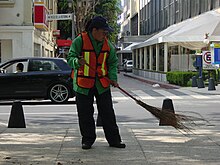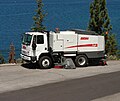Street sweeper

A compact street sweeper tackles litter in Mexico City

Street sweeper in Paseo de la Reforma in Mexico City
A street sweeper or street cleaner may refer to a person's occupation, or a machine that cleans streets. A street sweeper cleans the streets, usually in an urban area.
Street sweepers have been employed in cities since sanitation and waste removal became a priority. A street-sweeping person would use a broom and shovel to clean off litter, animal waste and filth that accumulated on streets. Later, water hoses were used to wash the streets.
Machines were created in the 19th century to do the job more efficiently. Today, modern street sweepers are mounted on truck bodies and can vacuum debris that accumulates in streets.
Contents
1 History
1.1 Mechanical sweepers in the United Kingdom
1.2 Mechanical sweepers in the United States
1.3 Technological advancement
2 Modern sweepers
2.1 Modern sweepers in Asia
2.2 Taiwan
2.3 United Kingdom
2.4 Uzbekistan
3 See also
4 References
5 External links
History
Mechanical sweepers in the United Kingdom

Mechanical street sweeper by Joseph Whitworth

Monument of street sweeper in St. Petersburg, in Russia
By the 1840s, Manchester, England, had become known as the first industrial city. Manchester was home to the first passenger rail service in the world and had one of the largest textile industries of that time. As a result, the robust metropolis was said to be England’s unhealthiest place to live.[1] In response to this unsanitary environment, Joseph Whitworth invented the mechanical street sweeper. The street sweeper was designed with the primary objective to remove rubbish from streets in order to maintain aesthetic goals and safety.[2][3]
Mechanical sweepers in the United States
The very first street sweeping machine was patented in 1849 by its inventor, C.S. Bishop. For a long time, street sweepers were just rotating disks covered with wire bristles. These rotating disks served as mechanical brooms that swept the dirt on the streets.[4]
A common misconception is that Charles Brooks invented the street sweeper in America in 1896. Brooks' design, far from being the "first street sweeper," was just a variation of what already existed, and the patent for it was among the more than 300 street sweeper patents issued in the United States before 1900. Most 19th-century sweepers, including the one in Brooks' patent, were horsecarts with no engine on board. The wheels on the cart turned gears or chains which drove the brush and belt. The first self-propelled sweeper vehicle patented in the USA, driven by steam engine and intended for cleaning railroad tracks was patented in 1868, patent #79606. Eureka C. Bowne was the first known woman to get a patent for a street sweeper in 1879, patent #222447. "Her success was great," wrote Matilda Joslyn Gage in The North American Review, Volume 136, Issue 318, May 1883.[5]
John M. Murphy called at the offices of American Tower and Tank Company in Elgin, Illinois, in the fall of 1911. He had a plan of a motor driven pickup street sweeper. The American Tower and Tank Company had been formed in 1903 by Charles A. Whiting and James Todd. They called in a recently acquired silent partner, Daniel M. Todd, and it was decided to hire Mr. Murphy and begin the development of his idea. That started what has become the Elgin Sweeper Company.[6]
After two years of trial, development, experimentation, and research, a sweeper was achieved which Murphy was satisfied performed all of the sweeping functions in the manner he had envisioned – one which partners James and Daniel M. Todd and Charles A. Whiting were willing to risk a reputation gained from 30 years manufacturing experience.[6]
In the fall of 1913, the City of Boise, Idaho, purchased the first Elgin Sweeper, following a demonstration. Boise Street Commissioner, Thomas Finegan, made a comparison showing a savings of $2,716.77 from the Elgin motorized sweeper when used rather than a horse-drawn sweeper.[6]
Following its introduction and initial sales, John M. Murphy continued the perfection of his sweeper. In 1917, US patents were filed and issues for J. M. Murphy, Street Sweeping machine #1,239,293.[6]
Technological advancement
The goal of simple debris removal did not change until the 1970s, when policymakers begun to reflect concern for water quality. In the United States, The lag time in which street sweepers responded can be pinpointed to the Runoff Report of 1998.[7] As older street sweepers were only effective in removing large particles of road debris, small particles of debris remained behind in large quantities.[8] The remaining debris was not seen as an aesthetic issue because rain would wash them away. Today, small particles are known to carry a substantial portion of the stormwater pollutant load.
Street sweeping can be an effective measure in reducing pollutants in stormwater runoff.[9] The Environmental Protection Agency considers street sweeping best practice in protecting water quality.
Modern sweepers

Newer mechanical street sweeper in Ohio
 Play media
Play mediaWalk behind street sweeper is used to clean a sidewalk alongside pedestrians
Newer street sweepers are capable of collecting small particles of debris.[2] Many street sweepers produced today are PM10 and PM2.5 certified,[3] meaning that they are capable of collecting and holding particulate matter sized less than 10μm and even down to 2.5μm.[10] Despite advancements in street sweeping technology, the mechanical broom type street sweeper accounts for approximately 90 percent of all street sweepers used in the United States today.[11]
Many modern street sweepers are equipped with water tanks and sprayers used to loosen particles and reduce dust. The brooms gather debris into a main collection area from which it is vacuumed and pumped into a collection bin or hopper. Others need no water but for example high-vacuum only to supress dust.
A regenerative air street sweeper uses forced air to create a swirling effect inside a contained sweeping head and then uses the negative pressure on the suction side to place the road debris inside a hopper. Debris is removed from the air by centrifugal separation, keeping particulate matter inside the hopper.[12] Many regenerative air sweepers are AQMD certified by their manufacturers and can pick up particles as small as 10 micrometres or less (PM10), a leading cause of stormwater pollution.
However a modern regenerative air street sweeper faces the challenge of noise level due to the fact that regenerative air street sweeper requires an extra engine to power the vacuum pump required to create the negative pressure for placing debris into a hopper.
Modern machines can cost $US300,000 each and a large city can remove upwards of 18,000 tons of materials annually via its fleet of sweepers. If poorly maintained, modern sweepers can have very poor cleaning performance.[13]
Modern sweepers in Asia

Green Star Mech Sweeper Taipei Port 2012
Sweeper manufacturers in Asia have also developed less sophisticated mechanical and regenerative air sweepers which differ in design to the American and European sweepers. China and Taiwan have both adapted the mechanical sweeper design of using two main brooms mounted vertically at the back of the hopper to carry debris into hopper. This design is less complicated and more cost effective than the mechanical belt and broom setup.

Grader-style vehicle using sweeper

Elgin Megawind

Vegetable oil (Pflanzenöl) powered vacuum cleaner truck (Laubsauger - "leaf vacuum cleaner"), Aachen, Germany
A Canadian "Madvac" compact streetsweeper in Mexico City Paseo de la Reforma

Eagle Model
Street sweeper in Cumbria, England
An MX - 450
Sweeper - Whirlwind

An Italian "Dulevo" street sweeper in Saint Peter's Square
Pelican street sweep
Single-engine Scarab Sweepers street sweeper in the pictured at the Dubai Autodrome, November 2006

Truck in New Jersey, June 2011

Bristles underneath truck are made of metal

Sweeper in New Jersey, 2012

Athey Mobil TopGun M-9D High Dump Street Sweeper
Taiwan
People in Taiwan have promoted street cleaning practices while commuting between home and office. Those who like to promote environmental protection concepts may also video tape their street cleaning processes and upload the footage to video sharing platforms (such as YouTube) for the purpose of educating the public to not litter on streets. According to the people doing street cleaning in Taiwan, the most frequent street debris in Taipei city are cigarette butts, plastic bags and plastic bottles.[citation needed]
United Kingdom
Young Muslims, who are volunteers of Ahmadiyya Muslim Youth Association (AMYA), are gathered in London, Manchester, Leicester and Cardiff downtown cities across UK when people are celebrating New Year's Day, which not only clean up the rubbish on streets but also show kindness and services of people in UK.[14]
Uzbekistan
While patients are waiting in line, technical staff, doctors and nurses in eastern Uzbekistan are sweeping the streets and collect garbage, but some people participating the street cleaning are forced labor that they pick up the rubbish out of compulsory duty to clean up the streets.[15]
See also
- Best management practice for water pollution
- Floor buffer
- Road debris
- Snow removal
- Storm drain
- Street Cleaning Simulator
- Street gutter
- Waste management in Taiwan
References
^ "A Brief History of Manchester"..mw-parser-output cite.citationfont-style:inherit.mw-parser-output .citation qquotes:"""""""'""'".mw-parser-output .citation .cs1-lock-free abackground:url("//upload.wikimedia.org/wikipedia/commons/thumb/6/65/Lock-green.svg/9px-Lock-green.svg.png")no-repeat;background-position:right .1em center.mw-parser-output .citation .cs1-lock-limited a,.mw-parser-output .citation .cs1-lock-registration abackground:url("//upload.wikimedia.org/wikipedia/commons/thumb/d/d6/Lock-gray-alt-2.svg/9px-Lock-gray-alt-2.svg.png")no-repeat;background-position:right .1em center.mw-parser-output .citation .cs1-lock-subscription abackground:url("//upload.wikimedia.org/wikipedia/commons/thumb/a/aa/Lock-red-alt-2.svg/9px-Lock-red-alt-2.svg.png")no-repeat;background-position:right .1em center.mw-parser-output .cs1-subscription,.mw-parser-output .cs1-registrationcolor:#555.mw-parser-output .cs1-subscription span,.mw-parser-output .cs1-registration spanborder-bottom:1px dotted;cursor:help.mw-parser-output .cs1-ws-icon abackground:url("//upload.wikimedia.org/wikipedia/commons/thumb/4/4c/Wikisource-logo.svg/12px-Wikisource-logo.svg.png")no-repeat;background-position:right .1em center.mw-parser-output code.cs1-codecolor:inherit;background:inherit;border:inherit;padding:inherit.mw-parser-output .cs1-hidden-errordisplay:none;font-size:100%.mw-parser-output .cs1-visible-errorfont-size:100%.mw-parser-output .cs1-maintdisplay:none;color:#33aa33;margin-left:0.3em.mw-parser-output .cs1-subscription,.mw-parser-output .cs1-registration,.mw-parser-output .cs1-formatfont-size:95%.mw-parser-output .cs1-kern-left,.mw-parser-output .cs1-kern-wl-leftpadding-left:0.2em.mw-parser-output .cs1-kern-right,.mw-parser-output .cs1-kern-wl-rightpadding-right:0.2em
^ ab Pitt R, Bannerman R, Sutherland R, 2004. The role of street cleaning in stormwater management, Environmental and Water Resources Institute of the American Society of Civil Engineers. 1-8
^ ab Chang Y, Chou C, Su K, Tseng C, 2004. Effectiveness of street sweeping and washing for controlling ambient TSP, Atmospheric Environment, 39: 1891–1902
^ "Archived copy". Archived from the original on 2011-12-30. Retrieved 2011-07-17.CS1 maint: Archived copy as title (link)
^ http://www.worldsweeper.com/History/ElevatorSweeperHistory.html
^ abcd (Source of Historic Information, The Sweep of Time by William A. Richman, 1962) (Information taken from published book)[full citation needed]
^ "Results of the Nationwide Urban Runoff Program" (PDF). Environmental Protection Agency. Retrieved 2013-12-16.
^ German, J.; Svensson, G. (2002). "Metal content and particle size distribution of street sediments and street sweeping waste". Water Science and Technology. 46 (6–7): 191–198. Archived from the original on 2013-12-17.
^ EPA - Stormwater Menu of BMPs Archived 2012-02-22 at the Wayback Machine
^ PM-10 Efficient Street Sweepers
^ Wildlife and Habitat | Ecosystems | Environmental Review Toolkit | FHWA
^ "How The Regenerative Air System Works". Tymco. Retrieved 11 March 2016.
^ Donovan, Kevin (8 October 2014). "Poorly maintained Toronto street sweepers can't do dirty work". Toronto Star. TorStar. Retrieved 8 October 2014.
^ Lucy Pasha-Robinson (2018-01-03). "Muslim youth group spends New Year's Day cleaning streets across UK". The Independent.
^ Khurmat Babajan, Farangis Najibullah (2018-07-09). "The Doctor Will See You -- As Soon As He's Done Street-Cleaning". RadioFreeEurope RadioLiberty.
External links
| Wikimedia Commons has media related to Street sweepers. |
Page, Walter Hines; Page, Arthur Wilson (April 1916). "Man And His Machines: Motor-Cycle Street Sweeper". The World's Work: A History of Our Time. XXXI: 694. Retrieved 2009-08-04.




















